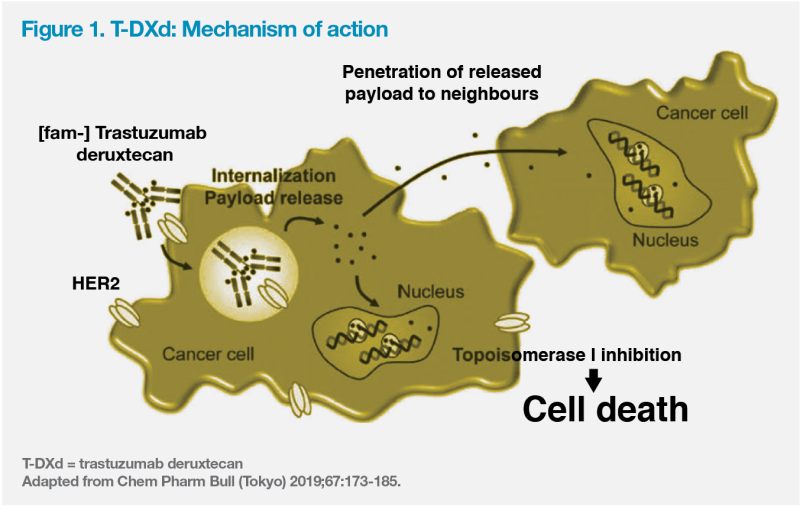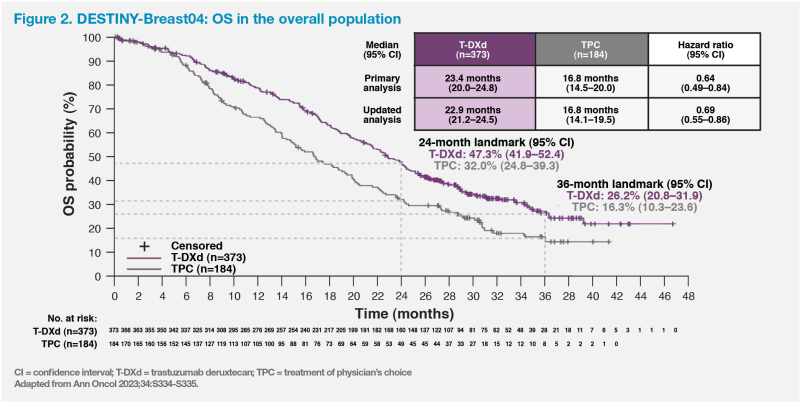T-DXd in HER2-low mBC: From molecular mechanism to clinical evidence and beyond





HER2-low metastatic breast cancer (mBC) is a heterogeneous disease with diverse clinicopathological characteristics and limited later-line treatment options. During an industry-sponsored symposium organized by the Hong Kong Breast Oncology Group, Dr Erika Hamilton of Sarah Cannon Research Institute, Tennessee, US, discussed molecular mechanism and clinical evidence on the use of trastuzumab deruxtecan (T-DXd; Enhertu®, Daiichi Sankyo & AstraZeneca) in pretreated HER2-low mBC.
HER2-low mBC: Characteristics and unmet needs
HER2, a key biomarker in breast cancer (BC) diagnosis, is evaluated through immunohistochemistry (IHC) and in situ hybridization (ISH). BC with low HER2 expression, defined as IHC score of 1+, or 2+ and a negative ISH result, is a heterogeneous disease with diverse clinicopathological features, including hormone receptor (HR) status. Low HER2 expression is present in 47–65 percent of HR-positive BC patients and 35–39 percent of those with triple-negative BC (TNBC). [J Clin Oncol 2020;38:1951-1962; npj Breast Cancer 2021;7:1; npj Breast Cancer 2021;7:137; JAMA Oncol 2022;8:1177- 1183]
Treatment approach to HER2-low mBC has generally followed that for HER2-negative disease, with limited therapeutic options in later-line settings. [Cancers (Basel) 2021;13:1015; Ann Oncol 2012;23:1441-1448; J Clin Oncol 2019;38:444-453] Later-line treatments have been shown to be of modest benefit in patients with HR-positive, HER2-negative mBC following progression on cyclin-dependent kinase 4/6 inhibitors, and those with HER2-negative disease previously treated with multiple chemotherapy regimens. [Clinc Breast Cancer 2022;22:143-148; J Clin Oncol 2015;33:594-601]
“Additional [later-line] therapeutic agents are needed for HER2-low mBC patients,” Hamilton pointed out.
T-DXd for HER2-low mBC: Why?
T-DXd is a HER2-targeted antibody drug conjugate (ADC) comprising a HER2-directed antibody conjugated to the topoisomerase I inhibitor via a tetrapeptide-based cleavable linker. “With a high drug-to-antibody ratio of 8:1, T-DXd enables efficient delivery of exatecan derivative [DXd] to HER2-positive cells,” explained Hamilton. “Upon internalization, T-DXd undergoes enzymatic cleavage, releasing DXd to induce DNA damage. Importantly, the bystander effect allows free DXd to target neighbouring cells lacking HER2 expression, making T-DXd effective in treating tumours with heterogeneous HER2 expression.” (Figure 1) [Chem Pharm Bull (Tokyo) 2019;67:173- 185; Cancer Sci 2016;107:1039-1046]

Antitumour activity and survival outcomes
A phase IB trial of T-DXd showed promising antitumour activity in patients with HER2-low advanced BC (n=54). At a median treatment duration of 6.1 months, the objective response rate (ORR) by independent central review (ICR) was 37.0 percent, and median progression-free survival (PFS) was 11.1 months. [J Clin Oncol 2020;38:1887- 1896]
Subsequently, the phase III, randomized DESTINY-Breast04 trial compared the efficacy and safety of T-DXd (5.4 mg/kg Q3W) vs treatment of physician’s choice (TPC) in 557 patients with HER2-low mBC previously treated with 1–2 lines of chemotherapy. Of these, 494 patients (88.7 percent) had HR-positive disease and 63 patients (11.3 percent) had HR-negative disease. The median number of treatment lines was 3. [N Engl J Med 2022;387:9-20]
DESTINY-Breast04 met its primary endpoint, showing a significant improvement in PFS with T-DXd vs TPC in the HR-positive cohort of 494 patients (median, 10.1 vs 5.4 months; hazard ratio, 0.51; 95 percent confidence interval [CI], 0.40–0.64; p<0.001) after a median follow-up of 18.4 months. In this cohort, median overall survival (OS) was 23.9 vs 17.5 months (hazard ratio, 0.64; 95 percent CI, 0.48–0.86; p=0.003).
In the total study population, PFS and OS were also significantly prolonged with T-DXd vs TPC (median PFS, 9.9 vs 5.1 months; hazard ratio, 0.50; 95 percent CI, 0.40–0.63; p<0.001) (median OS, 23.4 vs 16.8 months; hazard ratio, 0.64; 95 percent CI, 0.49–0.84; p=0.001). (Figure 2)

In the updated analysis after a median follow-up of 32 months, the investigator-assessed PFS improvement with T-DXd vs TPC remained consistent in both the HR-positive cohort (median, 9.6 vs 4.2 months; hazard ratio, 0.37; 95 percent CI, 0.30–0.46) and the total study population (median, 8.8 vs 4.2 months; hazard ratio, 0.36; 95 percent CI, 0.29–0.45), with a 63 and 64 percent reduction in risk of disease progression or death, respectively. [Ann Oncol 2023;34:S334-S335]
OS continued to favour T-DXd over TPC at 32-month follow-up, with median OS of 23.9 vs 17.6 months in the HR-positive cohort (hazard ratio, 0.69; 95 percent CI, 0.55–0.87) and 22.9 vs 16.8 months in the total study population (hazard ratio, 0.69; 95 percent CI, 0.55–0.86). “These results translated to approximately 6 months of OS benefit and a 31 percent reduction in risk of death in both the HR-positive cohort and the total study population,” highlighted Hamilton. (Figure 2)
In exploratory analyses in the HR-negative cohort (n=58; T-DXd group, n=40; TPC group, n=18), T-DXd demonstrated a median PFS by investigator of 6.3 vs 2.9 months with TPC (hazard ratio, 0.29; 95 percent CI, 0.15–0.57), and a median OS of 17.1 vs 8.3 months (hazard ratio, 0.58; 95 percent CI, 0.31–1.08). “Despite the small HR-negative cohort, T-DXd demonstrated a two-fold increase in [median] OS and a 42 percent reduction in death vs TPC,” Hamilton noted.
CNS activity
“T-DXd may benefit [HER2-low mBC] patients with central nervous system [CNS] involvement,” Hamilton said. In a DESTINY-Breast04 subgroup analysis of 35 patients with clinically stable, treated brain metastases (BMs) at baseline (T-DXd group, n=24; TPC group, n=11), the intracranial confirmed ORR was 25 percent with T-DXd vs 0 percent with TPC. In the T-DXd group, median intracranial PFS by blinded ICR was 9.7 months and median OS was 16.7 months. [Ann Oncol 2023;34:S342-343]
The open-label, phase II DEBBRAH study evaluated the efficacy of T-DXd in patients with pretreated HER2- positive or HER2-low advanced BC and a history of BMs and/or leptomeningeal carcinomatosis (LMC). Among 12 patients with asymptomatic untreated BM (cohort 2; n=6) or progressing BM after local treatment (cohort 4; n=6), T-DXd demonstrated intracranial ORR of 66.7 and 33.3 percent, respectively. [Cancer Res 2023;83:PD07-02] Notably, in 7 patients with pathologically confirmed LMC [cohort 5] who received T-DXd, median OS was 13.3 months and median PFS was 8.9 months at a median follow-up of 12 months. “These findings suggest that T-DXd may benefit mBC patients with LMC, a patient cohort with poor survival [median OS, 9–30.3 weeks] and substantial unmet clinical needs,” Hamilton commented. [Vaz Batista M, et al, SABCS 2023, abstract PS11-05; Am J Cancer Res 2013;3:117-126]
Safety and AE management
In DESTINY-Breast04, common adverse events (AEs) of all grades included nausea (73 percent for T-DXd vs 24 percent for TPC) and neutropenia (35 vs 53 percent). In the T-DXd group, grade 1 or 2 nausea and neutropenia occurred in 68 and 21 percent of patients, respectively. [Ann Oncol 2023;34:S334-S335]
Interstitial lung disease (ILD), an AE of special interest, occurred in 12.1 percent of patients in the T-DXd group, with 1.1 percent classified as grade 5 events. No new cases of ILD or pneumonitis were reported since the primary analysis.
Among patients with grade 1 asymptomatic ILD/pneumonitis, T-DXd administration is to be suspended until resolution to grade 0. Grade ≥2 symptomatic ILD/pneumonitis should prompt permanent discontinuation of the drug. [Enhertu Hong Kong Prescribing Information] “Early ILD detection is key to continuing T-DXd therapy. In my clinical practice, T-DXd–treated patients are screened [for ILD] every three cycles,” Hamilton advised.
Latest guidelines from the National Comprehensive Cancer Network (NCCN) categorize T-DXd as a highly emetogenic agent necessitating prophylactic antiemetics. [NCCN Clinical Practice Guidelines in Oncology, Antiemesis, version 2.2024] “In my practice, acute prophylaxis before the first T-DXd dose is typically a 3-drug regimen including aprepitant 125 mg, dexamethasone 8 mg and ondansetron 8 mg. If patients are free of nausea, aprepitant and/or steroids may be subsequently omitted,” Hamilton shared. “For those still experiencing nausea, I found that olanzapine 2.5 mg nocte is very effective.”
Future of HER2-low BC management
“HER2-low status has emerged as a biomarker for predicting T-DXd’s efficacy in patients with mBC,” Hamilton remarked. [Virchows Archiv 2024;484:3-14] In the randomized, phase III DESTINY-Breast06 trial, T-DXd showed a statistically significant and clinically meaningful PFS benefits vs TPC in HER2-low mBC patients who experience disease progression on endocrine therapy, including a “HER2- ultra-low” subset of patients with HER2 IHC score >0 or <1+. [Ther Adv Med Oncol 2023;15:1-16; J Clin Oncol 2024;42(17 Suppl)LBA1000]
“Pathology review of multiple tumour samples may be required for identifying patients with HER2-low disease. Moderate concordance between central and local testing, and dynamic HER2 expression in tumours over time may affect HER2 status assessment through IHC,” Hamilton said. [Virchows Archiv 2024;484:3-14; Cancer Res 2023;83:HER2-18; ESMO Open 2023;8:101615; Cancer Res 2023;83:HER2-10]
“HER2 expression could be a continuum, suggesting that [determining the threshold of HER2 level responsive to] novel anti-HER2 ADCs such as T-DXd could extend their use to a wider range of BC patients with [heterogenous] HER2 expression,” she added. [Cancer Discov 2022;12:2026- 2030]